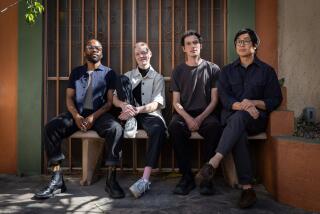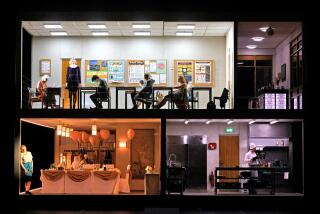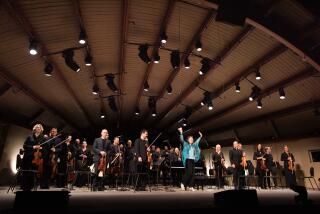JAZZ REVIEW : Crossover Drops Anchor at Queen Mary
- Share via
Jazz on a summer day--actually several spring days in this case--was every bit as alive last weekend at the Queen Mary Jazz Festival ’88 as it was 30 years ago at Newport when photographer Bert Stern made his classic jazz festival film.
But there were differences. Stern’s images of lazy sailboats scudding across the harbor to the accompaniment of Thelonious Monk’s ambling rhythms and Louis Armstrong’s gravelly vocalizing were replaced on Saturday and Sunday by a swarming panorama of powerboats clustered around the gigantic Queen Mary in Long Beach as a high decibel stream of fusion, funk and Latin jazz shattered the salt air breezes.
The festival’s decision to commit much of this year’s programming (with the notable exceptions of Friday’s collegiate bands and the headliner presence of trumpeter Wynton Marsalis on Sunday) to fusion, funk and Latin-styled performers provided significant testimony to the burgeoning selling power of these crossover styles. And, for the most part, it was a good artistic decision, as well.
Latin influences, of course, have been a part of jazz since Jelly Roll Morton identified the importance of the “Latin tinge.” The far-reaching range of that influence on the festival stretched from the staccato, samba-based scat lines of Tania Maria and Dianne Reeves to the Latin flavorings of Fattburger and the infectiously amiable dance rhythms of Tito Puente.
Fusion and funk became a significant part of jazz in the early ‘70s as the result of a simple desire on the part of young, jazz-trained musicians to create a music that would allow them to use the many newly developed electronic instruments, to break away from the song-based improvisations of post-War jazz, and to expand the possibilities of reaching the rapidly growing, rock-oriented audience.
But fusion and funk, as two days of music at the Queen Mary made amply clear, have many voices, some of which speak with a strong jazz flavor, and some of which have opted for the lingua franca of pop entertainment.
The most musically successful performers at the festival were generally those who retained the traditional values of jazz and used them as the foundation upon which to build fusion and funk constructions.
Drummer Alphonse Mouzon, for example, used an exceptionally fine sense of melody (as well as the vigorous keyboard work of Pat Coil) to balance the energetically percussive sound of his music.
Equally appealing were the Yellowjackets, who managed--especially in the playing of saxophonist Marc Russo and keyboardist Russell Ferrante--to integrate bebop-tinged improvising with slam-bang fusion rhythms.
Saxophonist Brandon Fields and bassist Stanley Clarke brought energy and fire to their sets, managing, by the sheer impact of their musical individualism, to break through the personality-numbing electronics associated with fusion.
Steel drummer/keyboardist Andy Narell, flutist Alexander Zonjic and keyboardists Dan Siegel and Jeff Lorber were somewhat less successful. Like many younger players, they often tended to confuse high-speed pyrotechnics with creative imagination and got lost in the fireworks.
Fusion at the festival reached its nadir with Hiroshima, a band whose early incarnation represented a fascinating attempt to integrate Asian sounds into a jazz environment. Few traces of those initial musical goals were evident in the ensemble which took the stage Saturday night.
Mugging to the audience, shamelessly mixing musical styles, playing with a superficial intensity more characteristic of Top 40 rock than jazz, Hiroshima was as slick, efficient and, ultimately, as characterless, as a brand new Toyota.
By the time the Queen Mary Festival wound toward its close Sunday night, virtually every aspect of fusion, funk and Latin had been touched upon. There was a certain quixotic logic, therefore, in the arrival of Wynton Marsalis’ quintet--a straight-ahead, contemporary jazz ensemble that seemed, in the context, to be almost anachronistic.
But Marsalis, taking the role of a passionate advocate of tradition, soon confirmed that there’s plenty of life left in pre-fusion styles, too. Playing with more heat than usual, he cruised through his now-familiar interpretation of “Caravan,” paused for a moment of lyricism on “Embraceable You,” and peaked with an almost perfect minor blues (which also featured extraordinary piano work from Marcus Roberts).
It was a fitting climax to a jazz festival which made a valiant effort to pay allegiance to the new without sacrificing the old.
More to Read
The biggest entertainment stories
Get our big stories about Hollywood, film, television, music, arts, culture and more right in your inbox as soon as they publish.
You may occasionally receive promotional content from the Los Angeles Times.










